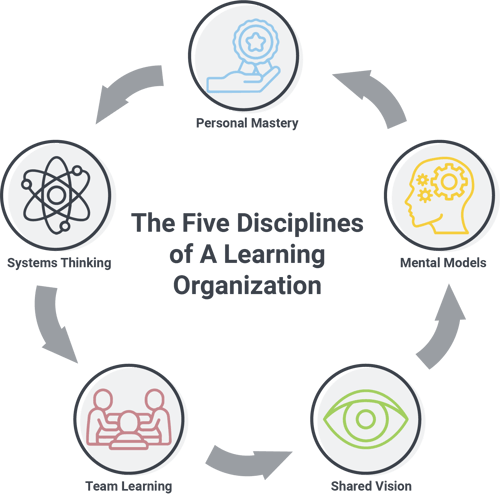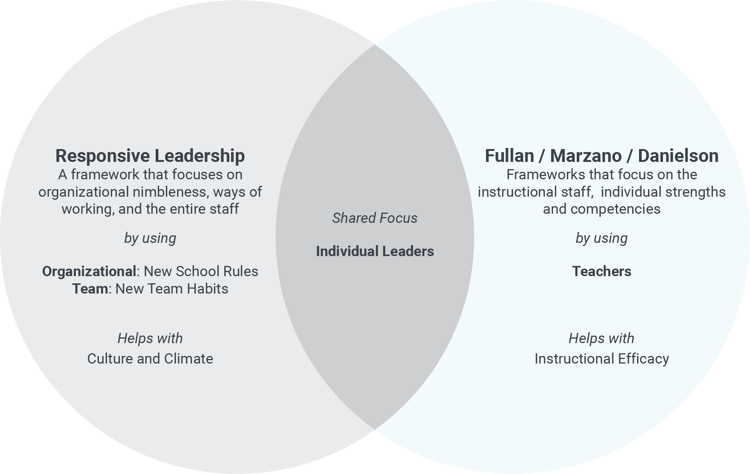Schools are foundational institutions in our communities and have to respond quickly to unforeseen challenges while maintaining strategic focus on educational excellence. This is a difficult line to walk; and K-12 school districts have not historically been known for their ability to adapt quickly or effectively to changing times and evolving needs. Schools may embrace new initiatives (and often do), but rarely retire old initiatives which leads to overloaded teachers, staff, and administrators struggling to add innovative solutions to established models.
And yet, in other parts of our lives, change and transformation are the norm. (Remember fax machines?) There are now jobs and roles that did not exist when we were growing up. We navigate our lives in very different ways. Importantly, it is also increasingly evident that many of our institutions, including K-12 schools, are not just out-of-date but have perpetuated deep-seated inequities. The need for more equitable learning and opportunity have pushed many in the education sector to work for foundational change over the years — with arguable success. Then COVID hit, and we saw firsthand our educators and students shift the entire instructional model on a dime, adopting new practices and new technology because that was the only way forward. (See these stories from leaders all over the country). A window of opportunity opened to not only rethink teaching and learning, but also to build more resilience and responsiveness in our school systems. With unprecedented funding and national focus on the critical role schools play in our society, this is a powerful moment in time to leap forward and resist any forces back to “school-as-we-knew-it.”
We believe that to build these nimble and resilient organizations, we need responsive leaders who are equipped with the skills and habits they will need to manage complex systems through changing times, while developing their students, staff, and communities — and they need to learn these skills quickly.
Responsive leadership across all sectors (not just education) focuses on the people within the organization as the reason for and pathway to organizational success. In schools and districts, responsive leadership is an approach that creates the culture, structures, and system for organizational learning, so the people who make up the school or district are able to learn from and with each other, developing their own skills and expertise as they maximize the capacity of the organization to achieve educational excellence for all students.
The idea of an organization that learns was first popularized by Peter Senge, in his book, The Fifth Discipline. According to Senge, learning organizations are, “organizations that encourage adaptive and generative learning, encouraging their employees to think outside the box and work in conjunction with other employees to find the best answer to any problem.” Learning organizations practice five disciplines:
The collective mastery of these disciplines requires a shared understanding that everyone in the community is a learner, and a precondition for collective learning is psychological safety. As Peter Senge writes in Schools that Learn, “This means involving everyone in the system in expressing their aspirations, building their awareness, and developing their capabilities together. In a school that learns, people who traditionally may have been suspicious of one another — parents and teachers, educators and local businesspeople, administrators and union members, people inside and outside the school walls, students and adults — recognize their common stake in each other’s future and the future of their community.” To facilitate this shift, leaders must have the necessary skills, habits, and mindset, AND the organization must embrace the five disciplines.
Leadership development for schools and districts is often framed around the individual leader’s traits and tactical expertise related to the specifics of their school or their district department. While this is a good start, limiting leadership development to these two areas can lead to inconsistencies within schools and districts, resulting in pockets of excellence and pockets of deficiencies, and can have a significant impact on the organization if leadership shifts or leaves. For responsive leadership to work, the individual and the organization BOTH need to be nimble and we need to think about them together — rather than separately as many theories of leadership have in the past.
We believe that leadership is an organizational trait — leadership development is most effective and impactful when it happens within the context of the organization. Responsive leadership is an approach that supports individual development within the context of team contribution and organizational purpose. We believe that schools grow when people grow, and that organizations that are structured to support continuous learning for all of the people who comprise the organization are organizations that survive and thrive.
K-12 schools and school districts are complicated hierarchical systems with legacy structures that have been adopted over the past 150 years, resulting in an organizational model that does not sufficiently meet the needs of our current society. In his research for Reinventing Organizations, Frederick LaLoux found that organizational models can, and have, evolved to meet the needs of the societies they serve.
In LaLoux’s model, organizations are created to meet the needs of the society, and public school systems exist in the same category – “Amber” – as the Catholic church and the military where they are characterized by formal roles, rigorous processes, and stability.
The advantages of organizations structured this way met the needs of the society at the time they were constructed: there was a need to have a stable and scalable approach to educating children to equip them to join the industrial workforce, and there were processes and systems in place to ensure the long term success of the model (the school calendar allowed for students to be away during planting season and return to resume their education with no impediment to their progress).
Growing inequities in learning and the shock of the global pandemic on our school systems have brought the limitations of an “Amber” model of school leadership into high-relief. Some would note that the military encountered similar limitations entering the fight against terror organizations like ISIS. General Stanley McChrystal recounts in his best seller, Team of Teams, how parts of the military needed to undergo a transformation to be more responsive, more networked, and more inclusive of the frontline leaders. For schools, the immediate and urgent challenges of educating through COVID have highlighted the need to create school systems that support responsive leaders who can rapidly adapt to the changing needs of their stakeholders.
We are in a potentially transformational time. Schools and districts have the opportunity to evolve into true learning organizations by building on the experiences they have had educating through a pandemic and developing responsive leaders and responsive organizations to help bring us to the future of learning.
Blog: Three Types of Leaders Every Learning Organization Should Have
Webinar: Responsive Leadership: Addressing the Urgent While Progressing Toward the Important
As we reflect on our work with more than 2,000 schools and districts, we know that the formula for creating a learning organization includes three key elements: Organization, Team, and Individual. Collective mastery requires a shared understanding of what it means to be responsive and how to achieve it at each level. Individual leaders’ development combined with responsive team habits and mindsets lead to a nimble learning organization. The steps outlined below provide a starting point and path forward for organizational leaders, team leaders, and individuals.
Organization Level Leaders
Superintendent, District Cabinet, School Leader
Consider your school or district’s capacity for organizational learning: read this article and take the survey included within as a start. The results of this survey can be used to guide your priorities. Go through the process above with your team, focusing your collective efforts on improving the elements that your organization needs.

As you focus on targeted leadership development based on the combinations of strengths and needs in each of your leaders, and align their development with organizational needs, the way your teams work together will escalate and amplify the work, or impede and diminish it.
Team Level Leaders
Division/Department Lead, Committee Lead, Principal, Team/Grade Lead
Consider how your teams support learning, using this article as a starting point. Begin shifting your team practices to support psychological safety and team learning.
Individual Leaders
Individuals should reflect on their own specific strengths and areas for growth within the Elements of Leadership.
Once you have practiced self-assessment, gathering feedback, practicing for improvement, and reflecting on your progress with an area for individual growth, align your development with organizational needs.
Blog: Why We Need Elements of Leadership
Video: How to Be a Good Leader | Innovative Leadership In Schools
Responsive leadership is framework agnostic: the Elements of Leadership are specific, learnable, measurable skills that can be combined to support all the teacher and leadership competencies that may be outlined in your school or district’s strategic plan, Teacher Evaluation framework, or state school leader competencies. Whether you are utilizing Charlotte Danielson’s Framework for Teaching, Marzano’s Focused School Leader Model, Fullan’s Coherence Framework, or a framework of your or your state’s making, the Responsive Leadership approach will support the successful development of you and your team in alignment with your strategic goals.
 The frameworks and related competencies that are in use in many schools and districts are a very clear articulation of what teachers and leaders need to do, and why. Our work supports school and district teams with understanding how they can get there.
The frameworks and related competencies that are in use in many schools and districts are a very clear articulation of what teachers and leaders need to do, and why. Our work supports school and district teams with understanding how they can get there.
Our approach starts with intentional alignment with your specific context, including your guiding frameworks, strategic priorities, and relevant competencies. We gather data, which could include a determination of the current state of organizational systems and structures, plans for school improvement, and stakeholder feedback through surveys, focus groups, and interviews, then use that to inform the goals and benchmarks for each phase of the work.
Blog: 6 Critical Issues in Educational Leadership and How to Address Them
Blog: Our Theory of Action for Developing Innovative Leadership in Schools